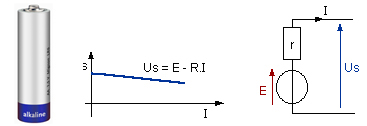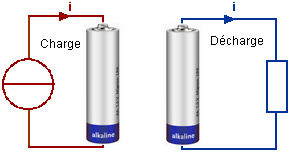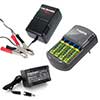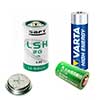Batteries and accumulators
Accumulators and batteries are electrochemical systems used to store energy. They render the in the form of electrical energy expressed in watt hours (Wh). Electricity is generated between two electrodes immersed in an electrolyte. The accumulator is based on a reversible electrochemical system. It is rechargeable as opposed to a battery that is not. The most commonly used batteries are saline or alkaline batteries.
The nominal voltage of a battery is 1, 5V. For batteries with higher voltage, it stacks the elements (9V battery). The internal resistance of a battery is important which has the effect of bringing down voltage when the current increases. The short circuit is therefore safe.

During charging, a battery is converted to receiver. The charge in Ampere current is generally 1/10 of the capacity in Ampere.heure (Ni-Cd). Some batteries such as Lithium-Ion batteries or even the Ni-Mh requires the use of charger 'intelligent' to control the load.

The load is done with a current generator constant.
| Type | Number of cycles for a discharge to 75% | Number of cycles for a discharge to 50% | Life expectancy in years at 20 ° C (permanent load) | Self-discharge per month |
| Liquid type motorcycle | 150 | 350 | 6 | 6% |
| AGM sealed type NP7-12 | 275 | 450 | 12 | 3% |
| Gel waterproof type A512/25 G | 420 | 650 | 12 | 2% |
Advice of charge
[A counselor]
- 1. prior to installing the batteries, please read the instructions of the device in which you intend to use the battery.
- 2. use the format and type of batteries as recommended by the manufacturer. Put the batteries in the camera polarity '+' and '-'.
- 3. charge the battery before use.
- 4 new batteries must be charged and discharged 2 or 3 times completely until they reach their maximum capacities. Batteries that have not been used for more than a week, must be recharged before a new use.
- 5. it is normal that the batteries will become hot during charging. They descend at room temperature as soon as they are loaded.
- 6. remove the batteries from the unit where you would not expect to use it for a certain period.
- 7. clean the surfaces of the battery contacts and channels reloads at the time where you replace the batteries. Use a dry cloth.
- 8. when your rechargeable benefits diminish greatly, you must replace them.
- 9 keep your batteries out of reach of children. If a battery is accidentally swallowed, contact a doctor immediately.
[To discourage]
- 1. do not other types of batteries such as alkaline, zinc carbon batteries, lithium batteries, rechargeable alkaline or other nonrechargeable batteries recharge. This can cause cracks and/or streaming batteries or again, it could result in personal injury and/or property damage.
- 2. do not charge batteries of different capacities at the same time, at least that the charger is equipped with individual loads channels.
- 3. do not charge batteries with different charges (for e.g. empty batteries or halves flat), unless the charger is equipped with individual load compartments.
- 4. do not overload your batteries to not reduce the life expectancy of these.
- 5. do use different batteries simultaneously (e.g. NiMH, NiCd, alkaline, etc.) and do not use batteries with different capacities at the same time in a single electronic application.
- 6. Please do not short-circuit, incinerate or disassemble the batteries.
- 7. do not dispose of batteries in fire as they may explode.
- 8. do not keep your batteries next to metal objects like coins, paper clips or hairpins to avoid e.g. short-circuit generates heat.
LEDs: the technological novelty of torches
The benefits of the LED:
- Durable and almost unbreakable
- Extremely effective power (longer battery life)
- Resistance to heat, cold and shock
- Life expectancy: 50000-100000 hours with a whiter light.
Comparison of cost for 200 hours of use:
| Torch LED + 2 batteries AA | Flashlight bulb filament + 2 AA batteries |
| 0 bulb | 0 bulb |
| Autonomy of 40-45 hours per set of batteries | Autonomy of 2-3 hours per set of batteries |
| Consumption: 10 batteries AA / 200 h | Consumption: 160 AA batteries / 200 h |
| Estimated cost: € 13 | Estimated cost: € 218 |
NOTE European
In the context of the regulatory European EC No * 1907/2006 of 18/12/2006 concerning the registration, evaluation, authorization and restriction of chemicals (reach) and in accordance with article 33, paragraph 1, we inform you that the entire range of button batteries and cylindrical lithium CR Varta contain the following product on the list of very high concern (SVHC) substances published by the Agency European chemicals (ECHA) June 18, 2012 1,2 - dinethoxyethane; ethylene glycol dimethyl ether (EGDME) - case n * 110-71 - 4 parallel batteries buttons NIMH rechargeable s Varta ref:55850704090 and 55850704190 contain the following products: Hexabromocyclododexine (HBCDD) - case No. * 25637-99-4 and its derivatives case n * 3194-55-6 and 134237-50-6/50-7 and 50-8
Express delivery
- By carrier or
- By Postal Service
Professional Quality
Secured Payment
Search in Blog
Par Josiane N. (Chatellerault, France métropolitaine) le 30 June 2025 :
Par Armelle G. (La trinité sur mer, France métropolitaine) le 26 June 2025 :
Par Rik L. (SART-DAMES-AVELINES, Belgique) le 25 June 2025 :















